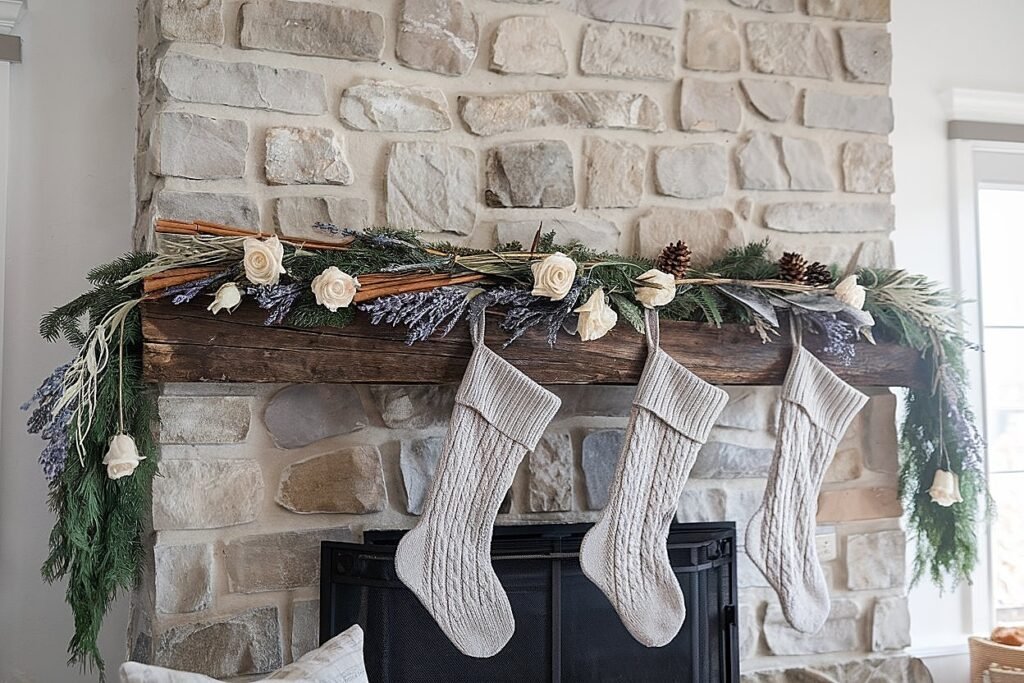
This website contains affiliate links, and some products are gifted by the brand to test. As an Amazon Associate, I earn from qualified purchases. Some of the content on this website was researched and created with the assistance of AI technology.
Key Takeaways
- Keep the palette disciplined (2–3 hues + one metal) so lavender and roses feel serene, not busy.
- Build structure first (greens and anchors), then weave in blooms and ribbon for finesse.
- Balance symmetry with one strong asymmetrical move to avoid a “catalog” look.
- Use vessels with character; vary heights and textures to catch candlelight.
- Edit ruthlessly—negative space makes flowers read intentional and luxe.
How to Create Lavender-Rose Christmas Mantel Displays isn’t just a look; it’s a mood—quiet, fragrant, and winter-calm. I reach for lavender when red-and-green feels too loud and the room is asking for softness. Roses bring romance, volume, and that little bit of holiday theater a fireplace deserves.
I’ll walk you through the exact process I use in client homes: rustic foundations, container choices, symmetry tricks, greenery blends, supporting colors, minimal styling, personal details, and creative accents. You’ll leave with a step-by-step plan—and the confidence to make it yours.
| 🌸 Styling Option | 🪞 Placement Ideas | ✨ Accent Details | 🏡 Farmhouse Pairing |
|---|---|---|---|
| Lavender-Rose Garland Mantel | Across mantel, cascading ends | Fairy lights, pinecones, lace ribbons | Distressed wood mantels & vintage mirrors |
| Rustic Mason Jar Displays | Evenly spaced along mantel | Burlap wrap, lace trims, twine bows | Farmhouse shelves & nightstands nearby |
| Lantern & Floral Mix | Mantel ends or hearth below | Candles, lavender bundles, rose petals | Rustic lanterns & side benches |
| Minimalist Lavender Touches | Mantel center focal points | Few lavender sprigs, neutral stockings | Natural linen textiles & wooden stools |
| Creative Accent Additions | Mixed across mantel garland | Ornaments, lace doilies, keepsake photos | Vintage dressers & farmhouse trunks |
How to Design a Rustic Lavender-Rose Mantel for Christmas
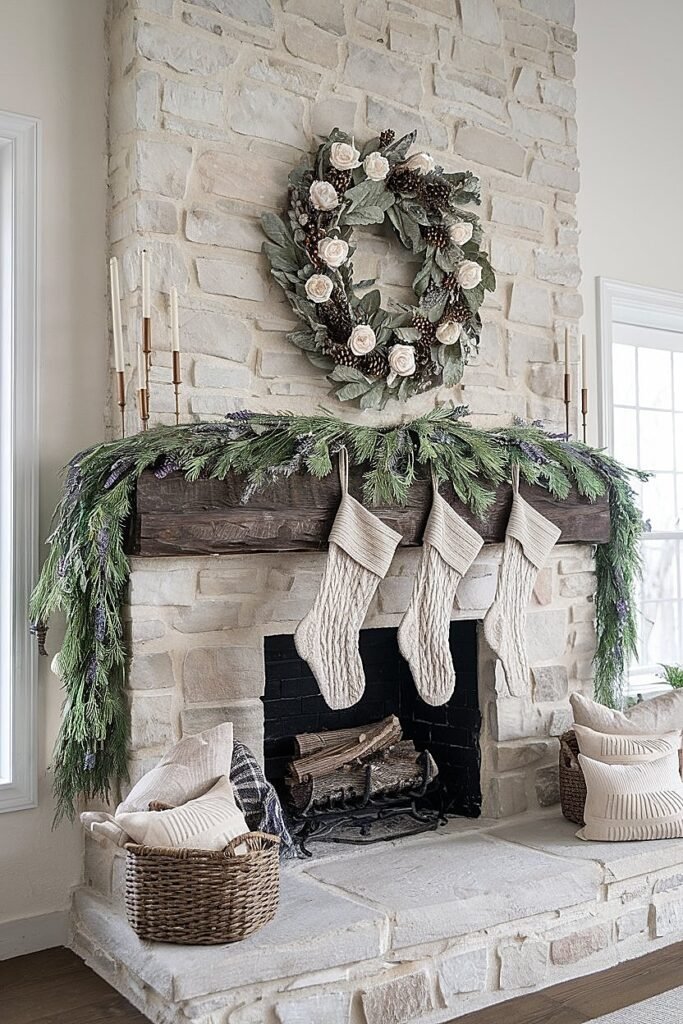
I start with the bones: a clean mantel, a centered mirror or art, and two sturdy attachment points under the ledge. That structure keeps the floral work from sliding once the room warms up.
Rustic doesn’t mean messy. It means honest materials—cedar, noble fir, juniper, linen ribbon, stoneware, aged brass—that let lavender and roses feel natural, not costume-y.
Lay a low cedar swag across the mantel, keeping weight slightly heavier on one side for movement. Wire in petite bundles of dried or fresh lavender every 8–10 inches so the color punctuates rather than carpets.
Add roses in small clusters (odd numbers) where the eye needs a beat—corners, under a sconce, near a mirror edge. Use short stems in water tubes hidden within the greens; keep faces angled slightly down to greet the room.
Finish with two brass tapers and a mid-height hurricane, never in a straight line. Tuck a thin velvet ribbon through the greenery like a trail—one loop, one tail, done. Step back, squint, and remove the loudest object; editing is your secret weapon.
If you want the whole room to harmonize, read my guide to Christmas Bedroom Styling with Roses and Lavender and, if this post helps, share it with a friend who loves calm holiday design. There’s more ahead—keep reading for container picks that make the flowers sing.
What Are the Best Containers for Lavender-Rose Christmas Mantel Arrangements?
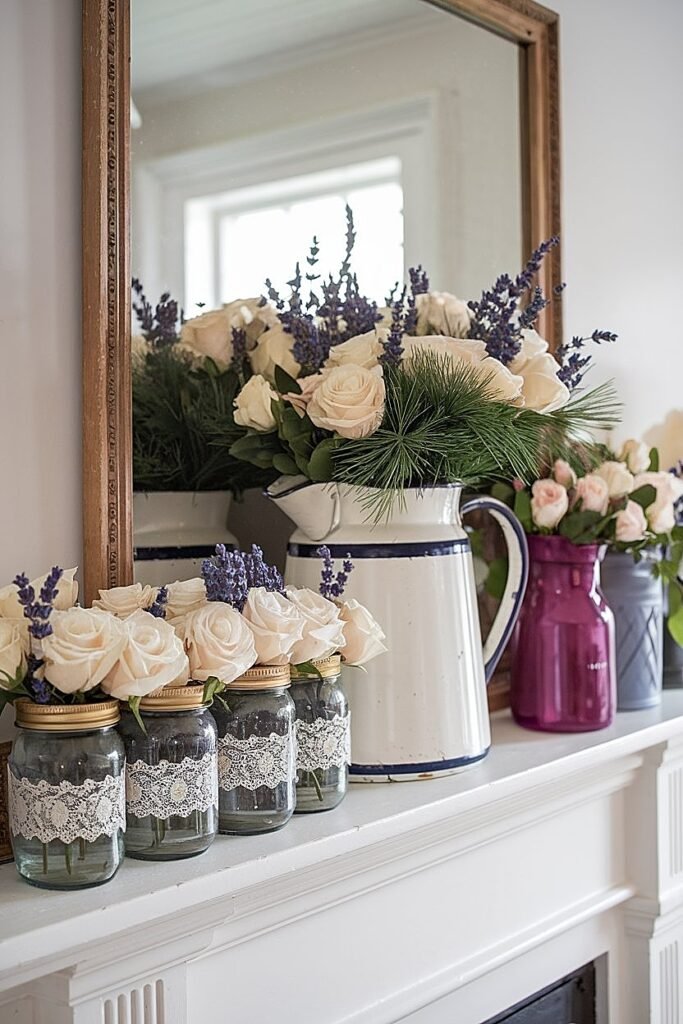
Containers set the tone before a single bloom lands. On a mantel, I favor low profiles and a few tall pieces that frame—not smother—the garland.
Mix materials confidently: matte ceramics, mercury glass, and aged metal create depth. Keep finishes within your palette so vessels feel embedded in the design.
I place one hero vessel off-center, then scatter bud vases to break up mass and add detail. Hidden water tubes inside the greens keep roses fresh while lavender—especially dried—can rest uncovered.
If your mantel is shallow, choose narrow-footed pieces and keep water weight centered so nothing teeters when the fire’s on.
9 Best Containers
- Matte Stoneware Trough — Low, weighty, and earthy. A trough stretches the garland’s line without stealing height, and its matte finish lets lavender’s soft purple read clearly. Nestle water tubes inside floral foam or chicken wire for stability; the long mouth supports rose clusters while preventing “flower clumps.” Works on rustic wood and painted mantels alike.
- Mercury-Glass Compotes — Small bowls with a gentle pedestal catch and amplify candlelight, giving roses that old-world glow. Cluster two or three to create rhythm along the swag. The reflective interior brightens pale petals, while the speckled exterior hides water spots. Ideal when you want romance without adding heavy visual mass.
- Aged Brass Bud Vases — Scatter five to seven across the greenery and drop in single rose buds or short lavender sprigs. The warm metal counterbalances lavender’s cool tone and connects to candleholders. Bud vases add height variation and micro-moments without clutter; they’re easy to refill mid-season with new stems.
- Narrow Ceramic Amphorae — Slim handles and a tapered neck create elegant verticals at the mantel ends. Keep stems short so blooms sit at the rim; let a lavender plume arc outward to echo the garland’s flow. The amphora silhouette reads classic without feeling formal, perfect for rustic-refined rooms.
- Clear Cylinder Hurricanes — These do double duty: protect candle flames and act as understated vases for low floral nests at the base. Use one tall and one medium to flank the focal area. The transparency preserves negative space so the arrangement breathes, and glass edges mirror light back into the flowers.
- Stone Mortar Bowls — Hefty and textural, they ground the sweetness of roses. A shallow bowl filled with floral foam supports tight, low clusters that won’t compete with the garland line. The stone’s cool tone pairs naturally with lavender and juniper berries, adding a subtle “winter garden” mood without looking staged.
- Patinated Copper Cups — Copper carries the warmth of firelight and bridges pink and purple petals. Use small cups in odd numbers, spaced irregularly. The metal’s orange undertone energizes blush roses while calming deeper mauves. Line with a leak-proof insert so copper doesn’t react with water or stems.
- White Porcelain Rectangles — Clean, modern, and great on painted mantels. A low rectangular trough creates a tidy runway for alternating lavender tufts and rose clusters. White brightens the palette and photographs beautifully at night. Add just one brass accent nearby to prevent the look from going clinical.
- Vintage Apothecary Bottles — A line of mismatched clear and smoke-glass bottles adds a collected feel. Drop in single stems at varying heights; repeat a motif (same ribbon or wax-seal tag) to unify the mix. Bottles are perfect for narrow mantels and give you an easy path to refresh blooms one at a time.
Pick two container “families” max—one anchor, one detail—so the flowers stay the story. If a vessel shouts louder than a rose, it’s the wrong star. More balance tips next—don’t stop now.
How to Balance Symmetry on Lavender-Rose Christmas Mantels
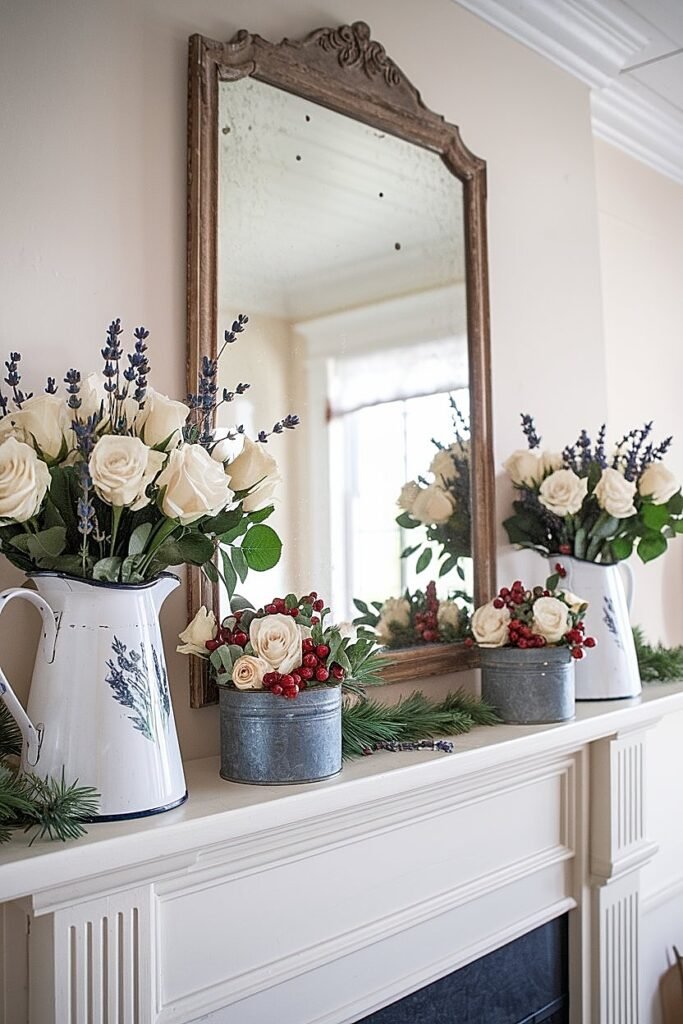
Symmetry feels formal, but total symmetry can look stiff. I aim for “calibrated balance”: twin gestures with one intentional disruption.
That disruption—an off-center hero vessel or a longer garland tail—creates life without creating chaos.
Start with mirrored anchors: two hurricanes or compotes equidistant from center. Lay your cedar swag evenly, then push one end two inches longer and lift the opposite side slightly higher.
Cluster roses in threes near each anchor, but add one extra cluster on the longer side. Thread lavender through both zones identically so scent and color stay unified.
Step back at night with the room lights dimmed; candlelight exaggerates asymmetry, so adjust then. When your eyes glide from end to end without tripping, you’ve hit balance. More greenery strategies are coming—keep reading.
Ways to Combine Greenery with Lavender and Roses on Christmas Mantels
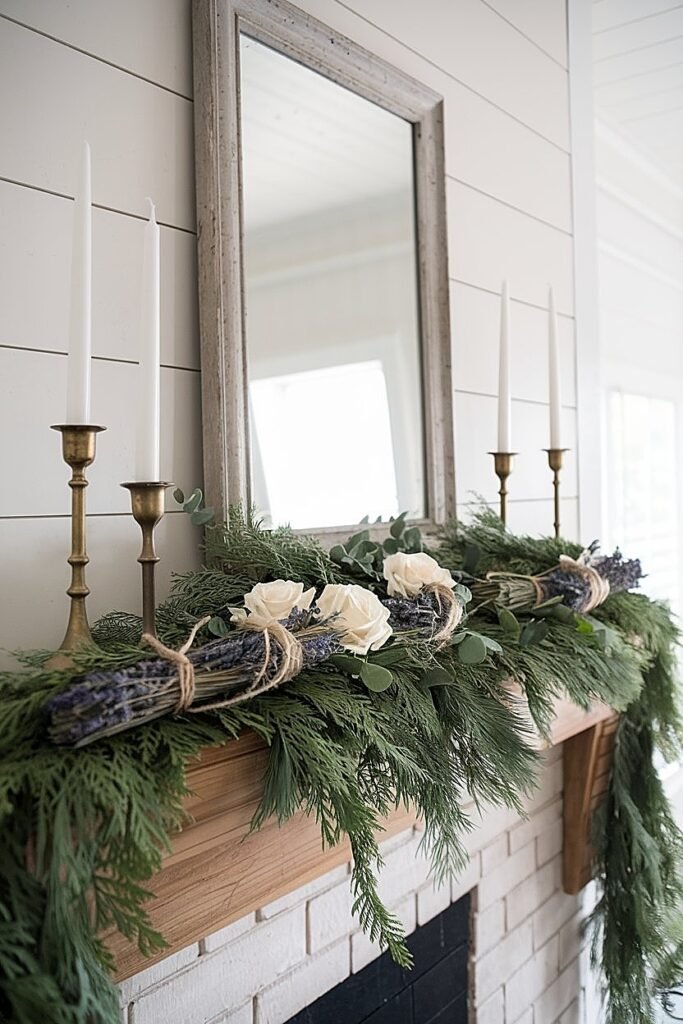
Greens are the skeleton; flowers are the expression. Choose varieties for role—drape, height, texture—then let lavender stitch everything together.
I build the spine first and add color only after the silhouette feels right.
Cedar creates the main line, noble fir adds height, and juniper cools the palette with blue berries that echo lavender. Eucalyptus (seeded or silver dollar) loosens the edges and brings movement.
Hydrate roses in hidden tubes; let dried lavender ride free. If using fresh lavender, treat stems like roses and keep them away from open flame.
5 Best Ways
- Cedar Base + Juniper Accents — Lay cedar for drape, then insert short juniper sprigs every 8–10 inches. The blue berries bridge lavender’s tone and make blush roses feel intentional. Keep juniper short so it reads as sparkle, not spikes; this combo photographs beautifully under warm bulbs.
- Noble Fir Risers — Use 3–4” fir tips behind key rose clusters to lift blooms into view. Fir holds shape for weeks, resists heat, and creates gentle terraces that keep petals from flattening against the mantel. Add lavender at the fir’s edge so color “peeks” from shadows.
- Eucalyptus Edgework — Tuck seeded eucalyptus along the garland’s lower lip to soften lines and introduce delicate bead textures. The cool green leans into lavender’s palette; it also dries gracefully, so the arrangement ages well.
- Magnolia for Contrast — Slide in a few magnolia leaves—green on top, velvety brown beneath—for rustic luxury. The warm underside harmonizes with copper and brass, while the glossy top keeps things fresh. Great for rooms with richer woods.
- Hemlock Sprays for Movement — Hemlock’s finer needles add airy motion without stealing structure. Use sparingly to break up heavy zones; let a bit drape past the mantel edge for a natural spill.
Pick three greens max and repeat them rather than adding more types. Consistency reads as intentional design. Next up: the accent colors that make lavender and roses glow.
What Are the Best Accent Colors for Lavender-Rose Christmas Mantels?
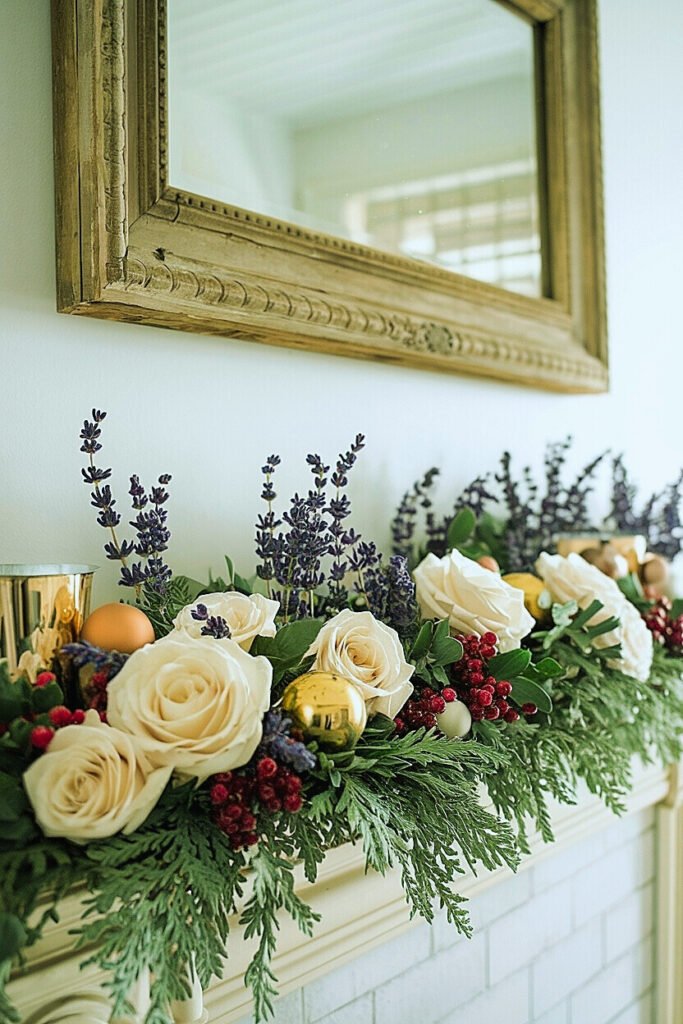
Color is where most designs wobble. You need one metallic and one supporting hue that respects your flowers.
Make choices under evening light; that’s when your mantel works hardest.
I tape ribbon swatches to the mantel and set two candles. If a trio looks calm from ten feet away, it’s in. If it fights, it’s out.
Mirror the palette in one more zone—sideboard or tree—so the house reads like one story.
7 Best Accent Colors
- Champagne — Warmer than silver, softer than gold. Champagne flatters blush roses and cool lavender without tilting brassy. Use on taper holders and ribbon edges; it photographs beautifully and won’t clash with nickel hardware.
- Aged Brass — Adds antique warmth and echoes firelight. Perfect with mauve and antique pink roses; pair with cedar for “heirloom” mood. Keep polish muted—high gloss can feel formal fast.
- Pewter — Cool and quiet. Pewter grounds pale roses and keeps a gray-lavender scheme crisp. Works with mercury glass and smoke glass accents.
- Rose Gold — A romantic bridge between lavender and blush petals. Use sparingly—a ribbon band or a single compote—so it reads as glow, not glitter.
- Matte Black — Minimal, modern counterpoint. A black lantern or bud vase sharpens the pastel palette and frames candlelight.
- Navy — Deep, wintry backdrop that makes lavender pop. Ribbon or a framed print is enough; avoid heavy ceramics that add visual weight.
- Copper — Rustic warmth that echoes orange candle flame and magnolia’s underside. Lovely with taupe and café-au-lait roses.
Choose one metal and one color accent; repeat them three times in small ways. That cadence feels intentional to the eye. Minimalists, you’re up next—keep going.
How to Style Lavender-Rose Christmas Mantels with Minimalism
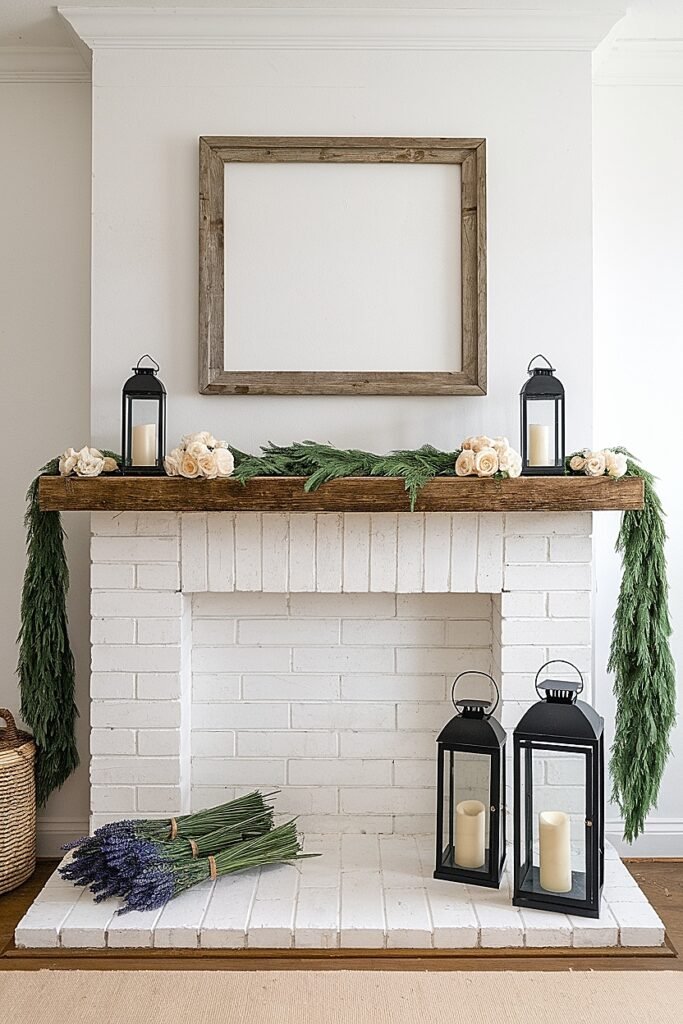
Minimal isn’t less work; it’s sharper decisions. You’ll rely on line, proportion, and light instead of ornament.
The payoff: the flowers look expensive because space frames them.
Use a single, low cedar line. Insert three tight rose clusters (left, center, right) and five precise lavender tufts between them. Add two identical hurricanes and stop.
Choose matte black or pewter for hardware; keep ribbon tonal and narrow. The whole story should read in one glance.
When in doubt, remove. If every element doesn’t raise the whole, it lowers it. Want to personalize without breaking the calm? Read on.
Ways to Add Personal Touches to Lavender-Rose Christmas Mantels
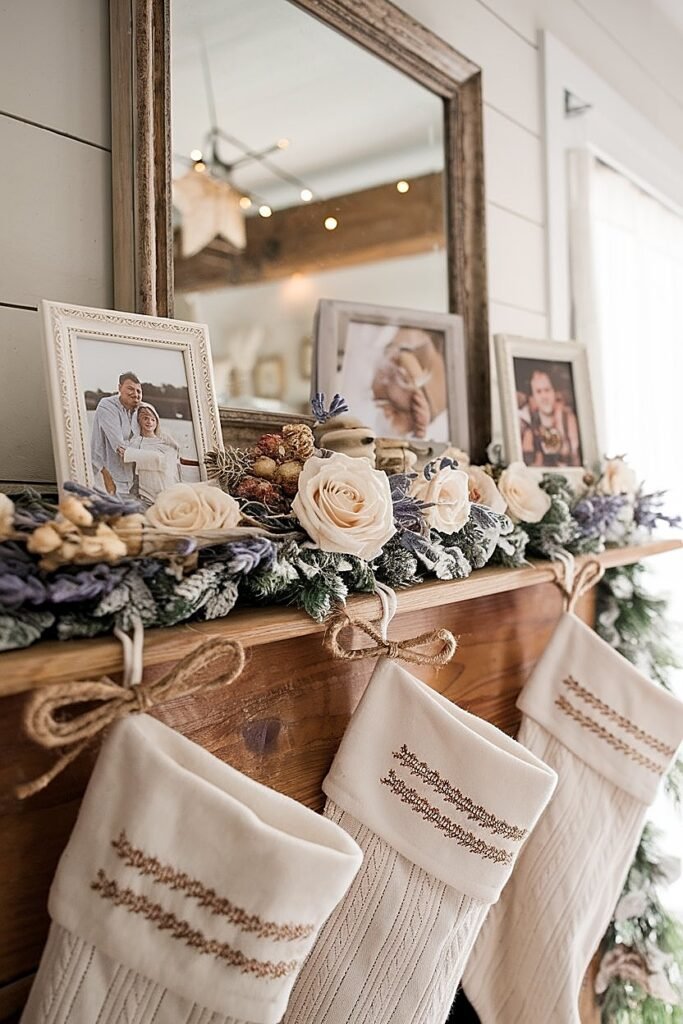
A mantel feels finished when it says something about the people living there. Personalization doesn’t mean clutter; it means meaning.
Keep items low-contrast so they whisper alongside the flowers.
I group keepsakes in odd numbers and tie them to the palette with ribbon, wax seals, or frames. The goal is discovery, not display case.
Rotate one personal piece weekly through December so the vignette feels alive.
- Framed Winter Sketches — Simple charcoal or ink drawings in thin black or pewter frames add intimacy without color noise. Prop on the mantel and tuck lavender sprigs behind the glass edge for a quiet scent moment.
- Hand-Stamped Ribbon Tags — Tie initials or dates onto bud vases or lanterns with narrow velvet ribbon in your palette. The tags read handmade and anchor small objects within the scheme.
- Vintage Postcards — Clip wintry postcards to a thin wire nested in the greens. The small scale invites guests closer while keeping the main composition clean.
- Heirloom Bells — A short strand of aged brass or copper bells draped from one corner adds sound and story; the metal tone mirrors your candleholders.
- Scent Bowls — Low stoneware bowls with star anise, cloves, or juniper berries add holiday fragrance without competing with dinner. A single lavender tuft on top ties scent to sight.
Limit personal elements to one cluster per three feet of mantel. The florals remain the star; your story plays supporting role. Next, I’ll show you how to spotlight lavender when roses dominate.
How to Highlight Lavender in Rose-Dominant Christmas Mantel Displays
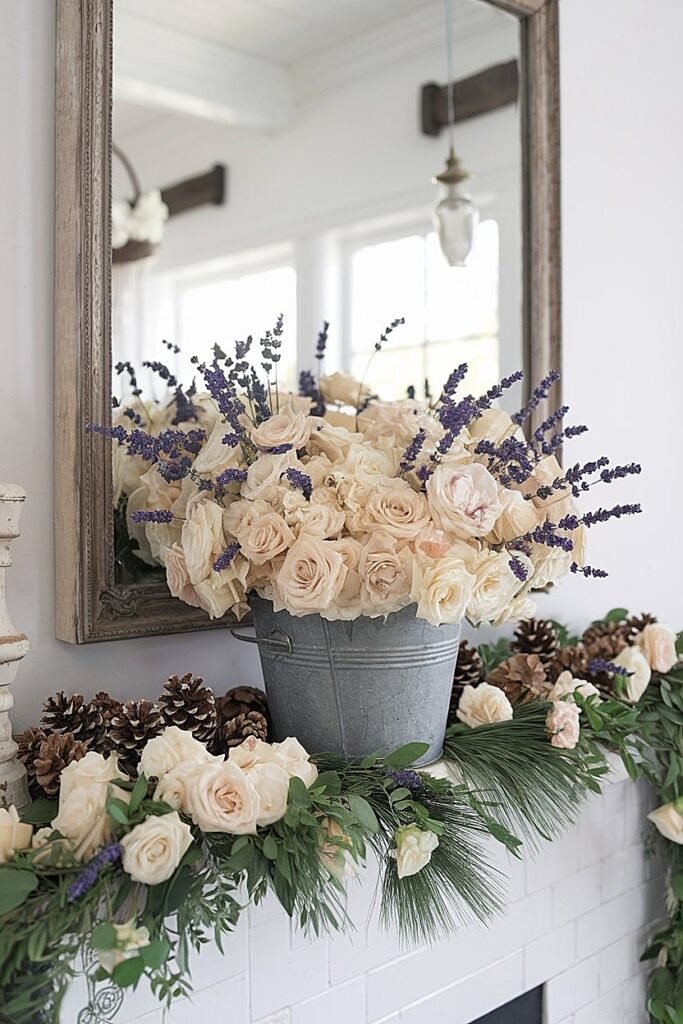
Sometimes the client wants big, lush roses—and lavender risks getting lost. I make lavender the thread, not the headline.
The trick: placement, repetition, and light.
Tuck lavender at the transition points—where cedar dips, where a compote meets greenery, where a candle halo catches. Keep sprigs short so color concentrates.
Repeat lavender in three vertical planes: within the garland, near candle bases, and as a small tuft tied to the mirror or wreath ribbon.
Hint: Under warm bulbs, lavender can gray out; add a single pewter or silver accent to cool the scene and let purple read true. We’re almost done—let’s play with creative accents.
What Are the Most Creative Lavender-Rose Mantel Christmas Accents?
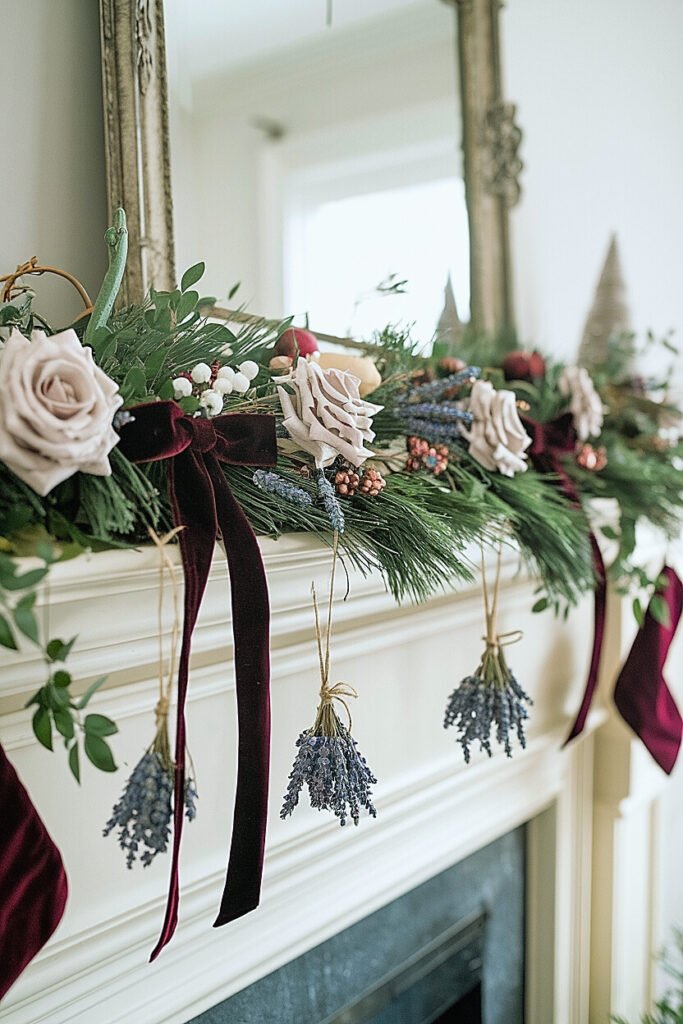
A few unexpected moves make the whole room feel designed, not decorated. Lean clever, not kitsch.
These accents earn their spot by adding motion, scent, or depth.
Pick one idea from the list so the mantel stays focused. Repeat its material or color once elsewhere—on the tree, sideboard, or table—for cohesion.
Keep anything heat-sensitive outside the flame path.
- Ribbon Waterfall — A single, narrow velvet ribbon drops from the mantel’s edge, pinned under greenery and pooling softly. It echoes lavender’s line and draws the eye down to stockings or a bench vignette.
- Lavender-Wax Seals — Press dried lavender into wax seals on tapered candle bases or bottle tags. Small, tactile, and delightfully old-world; it connects scent to sight without adding bulk.
- Smoke-Glass Layering — Slide a shallow smoke-glass panel behind the garland to create a shadow field. Flowers leap forward, candlelight diffuses, and the whole mantel gains depth without visual weight.
- Mini Bell Cluster — Five tiny bells wired together and tucked near one garland curve. The metal twinkle echoes candleholders and gives a soft jingle when air shifts.
- Apothecary Dome — A small glass cloche over a single rose and lavender tuft creates a museum-quiet moment. The dome magnifies detail while keeping petals away from heat.
- Juniper-Ink Place Cards — Yes, on the mantel. Hand-letter a seasonal word (“Calm,” “Gather”) and perch cards in stone holders within the greens. Intimate, inexpensive, and unexpectedly chic.
- Shadow-Line Lanterns — Two slender black lanterns set slightly behind the greens frame the composition and sharpen pastel tones; add LED tea lights to avoid heat.
Choose just one “trick” and repeat its material elsewhere once. That restraint keeps the mantel elevated. There’s more nuance packed through this guide—keep exploring and adapt freely.
Conclusion
A lavender-rose mantel rewards discipline: fewer colors, clear structure, gentle light, and meaningful details. Build your green spine first, weave in roses, stitch with lavender, then add one metallic and one accent color for polish. Keep symmetry honest, minimalism intentional, and personalization quiet. The result is calm, fragrant, and deeply welcoming—exactly what a winter room wants. If you found this useful, pass it to a friend who loves thoughtful holiday design.
This website contains affiliate links, and some products are gifted by the brand to test. As an Amazon Associate, I earn from qualified purchases. Some of the content on this website was researched and created with the assistance of AI technology.
